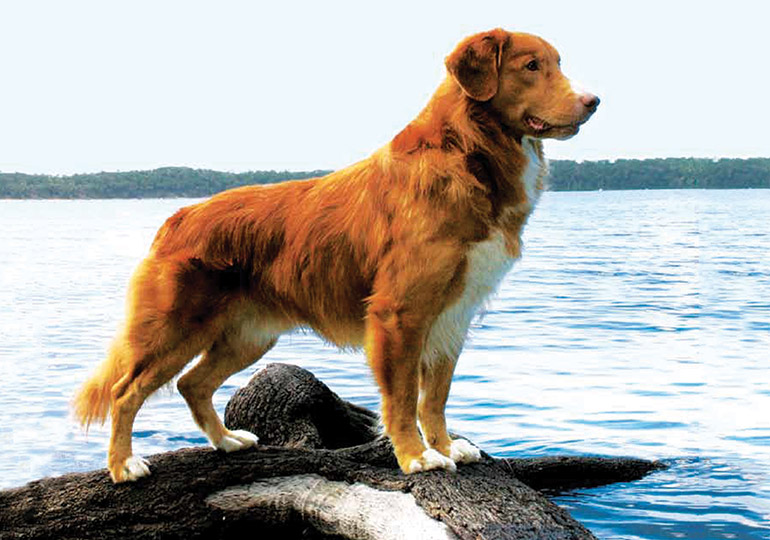Nova Scotia Duck Tolling Retriever
Breed Details
Size:
Exercise Requirements:
Grooming Requirements:
16-23 Kg (Approx)
16-17 years (Approx)

Appearance
It is widely believed that the Toller’s make-up includes a Kooikerhundje type dog, a decoy found in the lowlands of Europe, Belgium and Holland. The Kooiker is smaller, has a long plumed tail that it raises in action and is white with large patches of chestnut red, the opposite colouring to a Toller.
Today’s Toller is of medium size with a powerful, compact and well-muscled build. The breed may exhibit a slightly sad expression until it goes to work. From that point its aspect changes to one of intense concentration and excitement.
When at work, the Toller displays a speeding, rushing action, with the head carried out almost level with the back and its heavily feathered tail in constant motion.
The breed’s coat is made up of various shades of red or orange and usually features at least one of the following white markings: tip of tail, feet (not exceeding beyond the pasterns), chest and blaze. The coat may have a slight wave on the back, but is otherwise straight.
History
A versatile breed with a list of achievements longer than its name, the Nova Scotia Duck Tolling Retriever is a multitasker. History records an all-round farm dog of mixed origins that performed everyday chores such as pulling carts, herding sheep, enticing birds within range of the hunter and bringing back game.
The Toller’s medium to heavy bone structure enabled it to carry out such tasks.
This is of major importance, due to the need to enter icy waters to retrieve ducks as well as Canada geese. The Toller must also be nimble and agile – hence the movement transferring weight with a rear jaunty gait, typical of the breed. Yarmouth County, Nova Scotia, is the home of the originally named Little River Duck Dog or Little River Dog. As one travels around those parts of Canada, small Red Retrievers with or without white markings can be seen.
Temperament
The Toller is a wonderful dog to train. The breed exhibits great focus and excels in Agility, Flyball and jumping, as well as any activity that involves being a loyal companion to its owner. It is truly an all-round dog.
The breed is highly intelligent and displays a strong desire to both retrieve and play: these qualities are essential to its tolling ability. The Toller loves its family but can be reserved with strangers, without being aggressive or overly shy.
It is a suitable breed for families with children and other dogs, particularly those who lead an active lifestyle. Plenty of exercise is required to keep the Toller fit and happy and swimming is a great way to do this.
Care/Grooming
Considering the Nova Scotia Duck Tolling Retriever of today is derived from five dogs, it is a remarkably sound dog. Health issues are minimal and the breeders in Canada and elsewhere generously support university studies that have resulted in tests available for Heritable Thyroidism (USA lab), PRAcd and Collie Eye.
There are reports of late onset immune mediated disorders but these are common with many breeds. If fed natural foods and exercised well, the Toller is a hardy, healthy dog that can live for up to 16-17 years.
Since it was bred to retrieve from icy waters, the Toller has a water-repellent double coat of medium length and softness, and a more dense, softer undercoat. The breed is easy to care for and a weekly brush should keep its coat in check. The feathering around the ears requires occasional stripping to prevent tangles.
While neatening of the ears and feet is permitted, the Toller should always appear natural.
Breeders
Currently no Breeders in SA for this Breed

